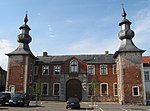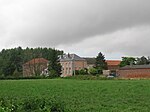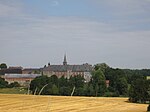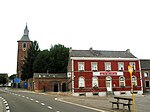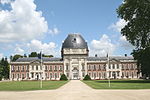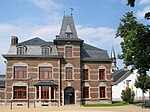The Battle of Ramillies (), fought on 23 May 1706, was a battle of the War of the Spanish Succession. For the Grand Alliance – Austria, England, and the Dutch Republic – the battle had followed an indecisive campaign against the Bourbon armies of King Louis XIV of France in 1705. Although the Allies had captured Barcelona that year, they had been forced to abandon their campaign on the Moselle, had stalled in the Spanish Netherlands and suffered defeat in northern Italy. Yet despite his opponents' setbacks Louis XIV wanted peace, but on reasonable terms. Because of this, as well as to maintain their momentum, the French and their allies took the offensive in 1706.
The campaign began well for Louis XIV's generals: in Italy Marshal Vendôme defeated the Austrians at the Battle of Calcinato in April, while in Alsace Marshal Villars forced the Margrave of Baden back across the Rhine. Encouraged by these early gains Louis XIV urged Marshal Villeroi to go over to the offensive in the Spanish Netherlands and, with victory, gain a 'fair' peace. Accordingly, the French Marshal set off from Leuven (Louvain) at the head of 60,000 men and marched towards Tienen (Tirlemont), as if to threaten Zoutleeuw (Léau). Also determined to fight a major engagement, the Duke of Marlborough, commander-in-chief of Anglo-Dutch forces, assembled his army – some 62,000 men – near Maastricht, and marched past Zoutleeuw. With both sides seeking battle, they soon encountered each other on the dry ground between the rivers Mehaigne and Petite Gette, close to the small village of Ramillies.
In less than four hours Marlborough's Dutch, English, and Danish forces overwhelmed Villeroi's and Max Emanuel's Franco-Spanish-Bavarian army. The Duke's subtle moves and changes in emphasis during the battle – something his opponents failed to realise until it was too late – caught the French in a tactical vice. With their foe broken and routed, the Allies were able to fully exploit their victory. Town after town fell, including Brussels, Bruges and Antwerp; by the end of the campaign Villeroi's army had been driven from most of the Spanish Netherlands. With Prince Eugene's subsequent success at the Battle of Turin in northern Italy, the Allies had imposed the greatest loss of territory and resources that Louis XIV would suffer during the war. Thus, the year 1706 proved, for the Allies, to be an annus mirabilis.
